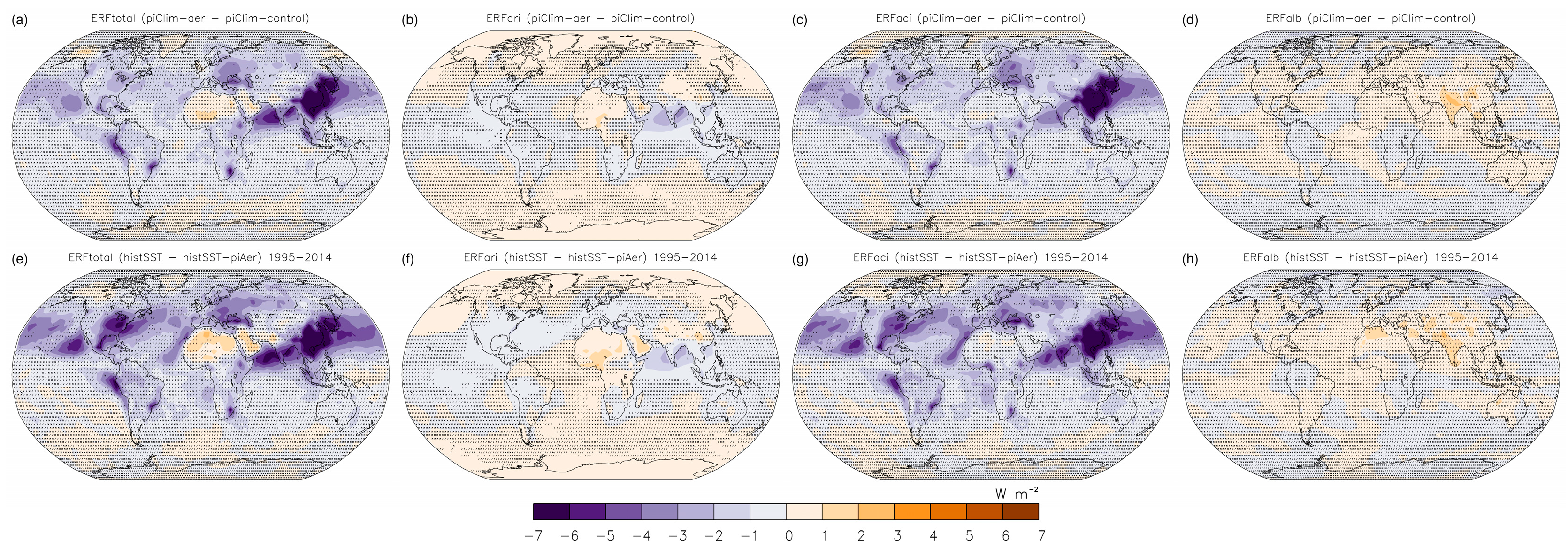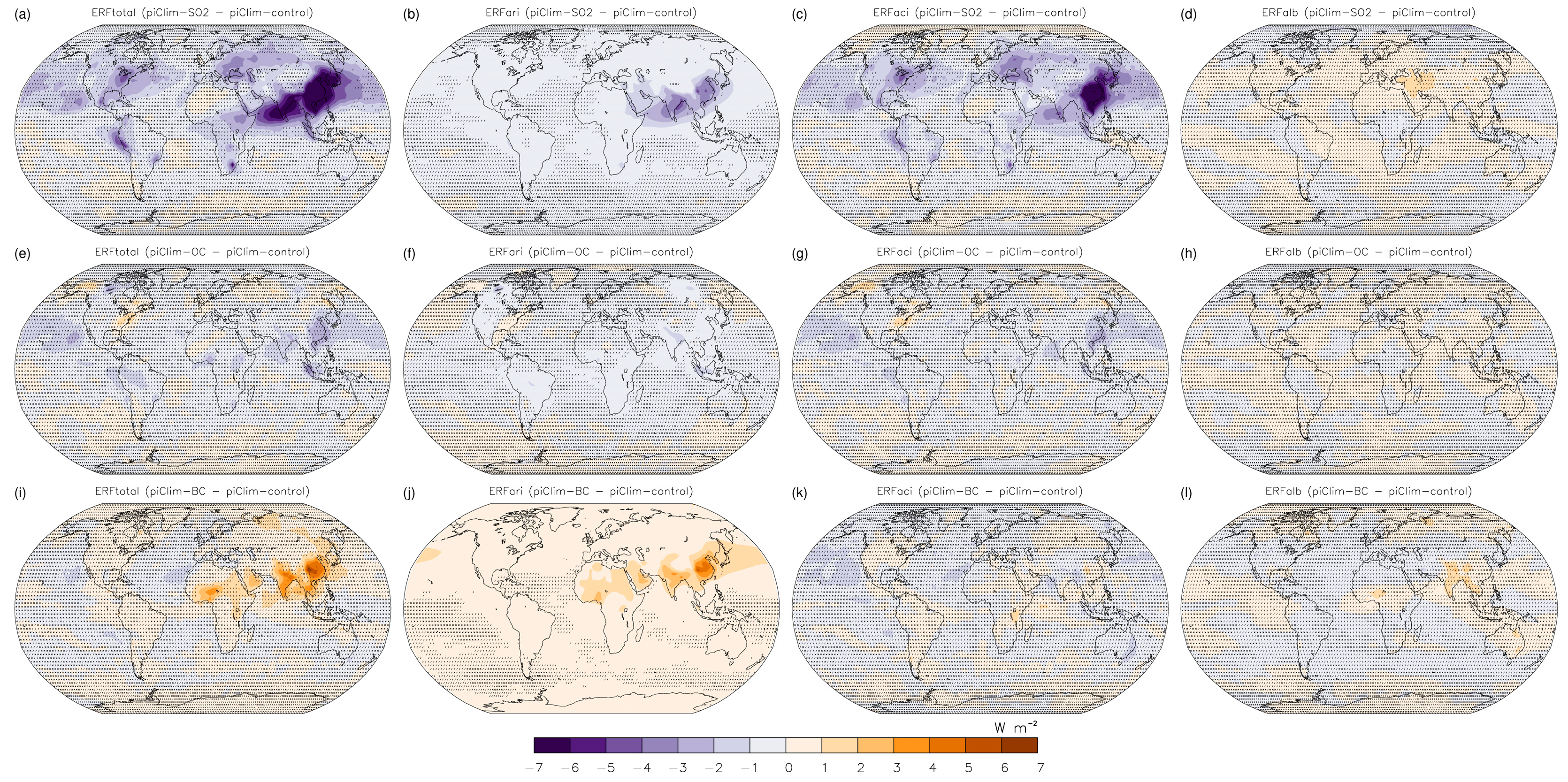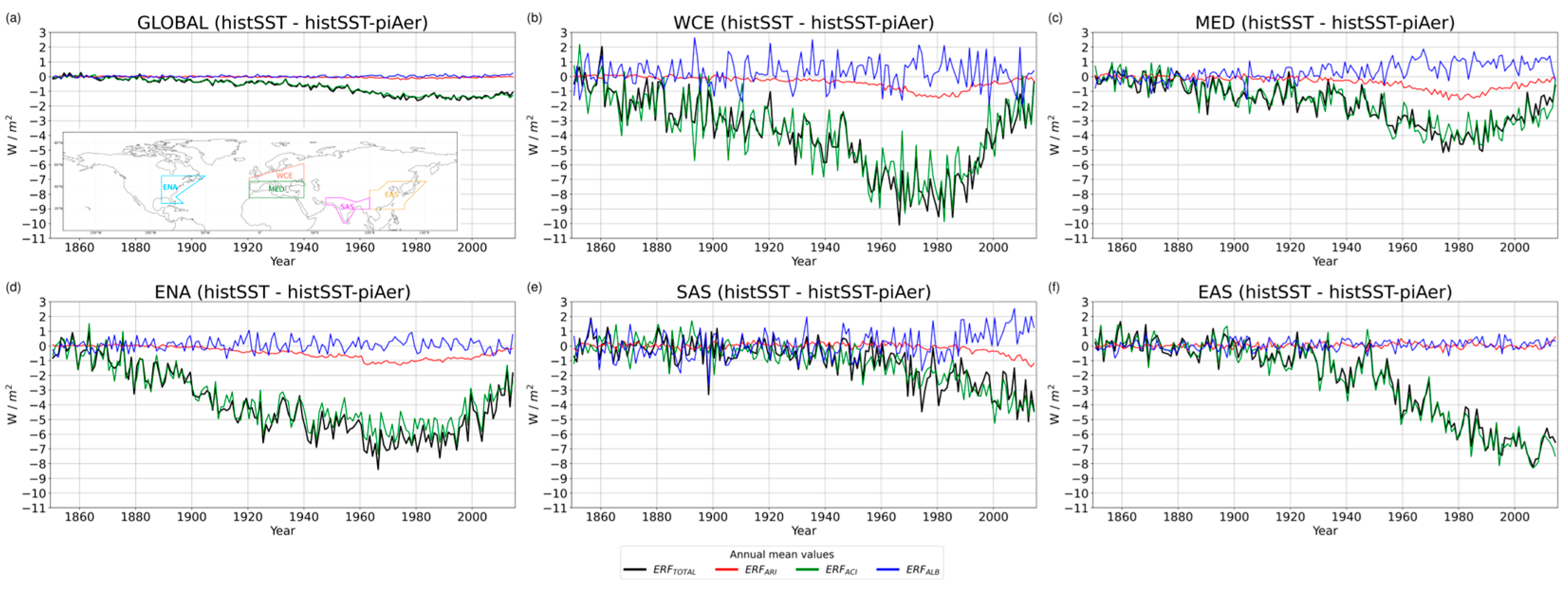Estimating the Effective Radiative Forcing of Anthropogenic Aerosols with the Use of CMIP6 Earth System Models †
Abstract
:1. Introduction
2. Data and Methodology
3. Results
4. Conclusions
Author Contributions
Funding
Institutional Review Board Statement
Informed Consent Statement
Data Availability Statement
Acknowledgments
Conflicts of Interest
References
- Boucher, O.; Randall, D.; Artaxo, P.; Bretherton, C.; Feingold, G.; Forster, P.; Kerminen, V.-M.; Kondo, Y.; Liao, H.; Lohmann, U.; et al. Clouds and Aerosols. In Climate Change 2013: The Physical Science Basis. Working Group I Contribution to the Fifth Assessment Report of the Intergovernmental Panel on Climate Change; Stocker, T.F., Qin, D., Plattner, G.-K., Tignor, M., Allen, S.K., Boschung, J., Nauels, A., Xia, Y., Bex, V., Midgley, P.M., Eds.; Cambridge University Press: Cambridge, UK; New York, NY, USA, 2013; pp. 571–658. [Google Scholar]
- Bellouin, N.; Quaas, J.; Gryspeerdt, E.; Kinne, S.; Stier, P.; Watson-Parris, D.; Boucher, O.; Carslaw, K.S.; Christensen, M.; Daniau, A.-L.; et al. Bounding Global Aerosol Radiative Forcing of Climate Change. Rev. Geophys. 2020, 58, e2019RG000660. [Google Scholar] [CrossRef]
- Szopa, S.; Naik, V.; Adhikary, B.; Artaxo Netto, P.E.; Berntsen, T.; Collins, W.D.; Fuzzi, S.; Gallardo, L.; Kiendler-Scharr, A.; Klimont, Z.; et al. Short-Lived Climate Forcers. In Climate Change 2021: The Physical Science Basis. Contribution of Working Group I to the Sixth Assessment Report of the Intergovernmental Panel on Climate Change; Masson-Delmotte, V., Zhai, P., Pirani, A., Connors, S.L., Péan, C., Berger, S., Caud, N., Chen, Y., Goldfarb, L., Gomis, M.I., et al., Eds.; Cambridge University Press: Cambridge, UK; New York, NY, USA, 2021; pp. 817–922. [Google Scholar]
- Lund, M.T.; Samset, B.H.; Skeie, R.B.; Watson-Parris, D.; Katich, J.M.; Schwarz, J.P.; Weinzierl, B. Short Black Carbon Lifetime Inferred from a Global Set of Aircraft Observations. npj Clim. Atmos. Sci. 2018, 1, 31. [Google Scholar] [CrossRef]
- Haywood, J.; Boucher, O. Estimates of the Direct and Indirect Radiative Forcing Due to Tropospheric Aerosols: A Review. Rev. Geophys. 2000, 38, 513–543. [Google Scholar] [CrossRef]
- Lohmann, U.; Feichter, J. Global Indirect Aerosol Effects: A Review. Atmos. Chem. Phys. 2005, 5, 715–737. [Google Scholar] [CrossRef]
- Ramaswamy, V.; Collins, W.; Haywood, J.; Lean, J.; Mahowald, N.; Myhre, G.; Naik, V.; Shine, K.P.; Soden, B.; Stenchikov, G.; et al. Radiative Forcing of Climate: The Historical Evolution of the Radiative Forcing Concept, the Forcing Agents and Their Quantification, and Applications. Meteorol. Monogr. 2019, 59, 14.1–14.101. [Google Scholar] [CrossRef]
- Forster, P.; Storelvmo, T.; Armour, K.; Collins, W.; Dufresne, J.-L.; Frame, D.; Lunt, D.J.; Mauritsen, T.; Palmer, M.D.; Watanabe, M.; et al. The Earth’s Energy Budget, Climate Feedbacks, and Climate Sensitivity. In Climate Change 2021: The Physical Science Basis. Contribution of Working Group I to the Sixth Assessment Report of the Intergovernmental Panel on Climate Change; Masson-Delmotte, V., Zhai, P., Pirani, A., Connors, S.L., Péan, C., Berger, S., Caud, N., Chen, Y., Goldfarb, L., Gomis, M.I., et al., Eds.; Cambridge University Press: Cambridge, UK; New York, NY, USA, 2021; pp. 923–1054. [Google Scholar]
- Eyring, V.; Bony, S.; Meehl, G.A.; Senior, C.A.; Stevens, B.; Stouffer, R.J.; Taylor, K.E. Overview of the Coupled Model Intercomparison Project Phase 6 (CMIP6) Experimental Design and Organization. Geosci. Model Dev. 2016, 9, 1937–1958. [Google Scholar] [CrossRef]
- Ghan, S.J. Technical Note: Estimating Aerosol Effects on Cloud Radiative Forcing. Atmos. Chem. Phys. 2013, 13, 9971–9974. [Google Scholar] [CrossRef]
- Collins, W.J.; Lamarque, J.-F.; Schulz, M.; Boucher, O.; Eyring, V.; Hegglin, M.I.; Maycock, A.; Myhre, G.; Prather, M.; Shindell, D.; et al. AerChemMIP: Quantifying the Effects of Chemistry and Aerosols in CMIP6. Geosci. Model Dev. 2017, 10, 585–607. [Google Scholar] [CrossRef]
- Gutiérrez, J.M.; Jones, R.G.; Narisma, G.T.; Muniz Alves, L.; Amjad, M.; Gorodetskaya, I.V.; Grose, M.; Klutse, N.A.B.; Krakovska, S.; Li, J.; et al. Atlas. In Climate Change 2021: The Physical Science Basis. Contribution of Working Group I to the Sixth Assessment Report of the Intergovernmental Panel on Climate Change; Masson-Delmotte, V., Zhai, P., Pirani, A., Connors, S.L., Péan, C., Berger, S., Caud, N., Chen, Y., Goldfarb, L., Gomis, M.I., et al., Eds.; Cambridge University Press: Cambridge, UK; New York, NY, USA, 2021; pp. 1927–2058. [Google Scholar]



| Model | piClim Variant Label | histSST Variant Label |
|---|---|---|
| CNRM-ESM2-1 | r1i1p1f2 | - |
| EC-Earth3-AerChem | - | r1i1p1f1 |
| GFDL-ESM4 | r1i1p1f1 | r1i1p1f1 |
| MPI-ESM-1-2-HAM | r1i1p1f1 | r1i1p1f1 |
| MRI-ESM2-0 | r1i1p1f1 | - |
| NorESM2-LM | r1i1p1f1 | r1i1p1f1 |
| UKESM1-0-LL | r1i1p1f4 | r1i1p1f2 |
| Experiment | N2O | CH4 | Aerosol Precursors | CFC/ HCFC | Ozone Precursors |
|---|---|---|---|---|---|
| piClim-control | 1850 | 1850 | 1850 | 1850 | 1850 |
| piClim-aer | 1850 | 1850 | 2014 | 1850 | 1850 |
| piClim-SO2 | 1850 | 1850 | 1850 (non-SO2) 2014 (SO2) | 1850 | 1850 |
| piClim-OC | 1850 | 1850 | 1850 (non-OC) 2014 (OC) | 1850 | 1850 |
| piClim-BC | 1850 | 1850 | 1850 (non-BC) 2014 (BC) | 1850 | 1850 |
| histSST | Hist | Hist | Hist | Hist | Hist |
| histSST-piAer | Hist | Hist | 1850 | Hist | Hist |
| Experiment | ERFtotal | ERFari | ERFaci | ERFalb |
|---|---|---|---|---|
| piClim-aer | −1.04 | −0.04 | −1.05 | 0.05 |
| piClim-SO2 | −1.09 | −0.32 | −0.81 | 0.04 |
| piClim-OC | −0.32 | −0.08 | −0.26 | 0.01 |
| piClim-BC | 0.20 | 0.39 | −0.20 | 0.01 |
| histSST | −1.33 | −0.04 | −1.35 | 0.06 |
Disclaimer/Publisher’s Note: The statements, opinions and data contained in all publications are solely those of the individual author(s) and contributor(s) and not of MDPI and/or the editor(s). MDPI and/or the editor(s) disclaim responsibility for any injury to people or property resulting from any ideas, methods, instructions or products referred to in the content. |
© 2023 by the authors. Licensee MDPI, Basel, Switzerland. This article is an open access article distributed under the terms and conditions of the Creative Commons Attribution (CC BY) license (https://creativecommons.org/licenses/by/4.0/).
Share and Cite
Kalisoras, A.; Georgoulias, A.K.; Akritidis, D.; Allen, R.J.; Naik, V.; Zanis, P. Estimating the Effective Radiative Forcing of Anthropogenic Aerosols with the Use of CMIP6 Earth System Models. Environ. Sci. Proc. 2023, 26, 40. https://doi.org/10.3390/environsciproc2023026040
Kalisoras A, Georgoulias AK, Akritidis D, Allen RJ, Naik V, Zanis P. Estimating the Effective Radiative Forcing of Anthropogenic Aerosols with the Use of CMIP6 Earth System Models. Environmental Sciences Proceedings. 2023; 26(1):40. https://doi.org/10.3390/environsciproc2023026040
Chicago/Turabian StyleKalisoras, Alkiviadis, Aristeidis K. Georgoulias, Dimitris Akritidis, Robert J. Allen, Vaishali Naik, and Prodromos Zanis. 2023. "Estimating the Effective Radiative Forcing of Anthropogenic Aerosols with the Use of CMIP6 Earth System Models" Environmental Sciences Proceedings 26, no. 1: 40. https://doi.org/10.3390/environsciproc2023026040
APA StyleKalisoras, A., Georgoulias, A. K., Akritidis, D., Allen, R. J., Naik, V., & Zanis, P. (2023). Estimating the Effective Radiative Forcing of Anthropogenic Aerosols with the Use of CMIP6 Earth System Models. Environmental Sciences Proceedings, 26(1), 40. https://doi.org/10.3390/environsciproc2023026040








